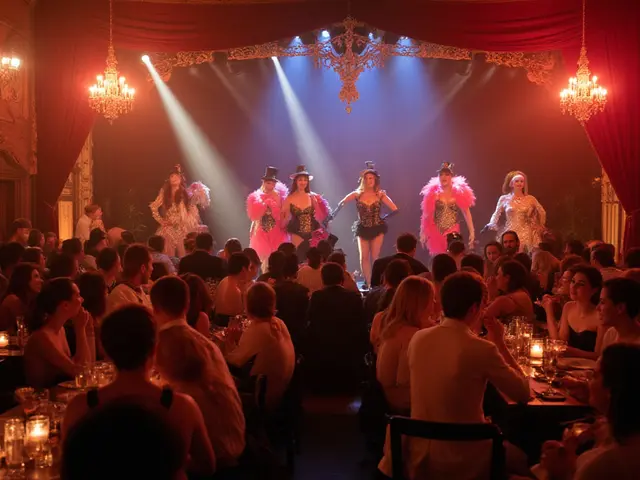Top Models Breaking New Ground in 2025
You’ve seen them on billboards, Instagram feeds, and opening shows at Paris Fashion Week. But the top models of 2025 aren’t just walking runways-they’re rewriting the rules. Gone are the days when one body type, one skin tone, or one look dominated the industry. Today’s top models aren’t just beautiful-they’re bold, unapologetic, and driving real change.
Remember when models were chosen for how closely they matched a designer’s vague idea of "ideal"? That’s over. Now, brands are scrambling to sign models who reflect the world we actually live in. And the ones rising to the top? They’re not waiting for permission. They’re creating their own opportunities.
What Makes a Model "Top" in 2025?
Being a top model today isn’t just about height, measurements, or a perfect portfolio. It’s about influence. It’s about having a voice. It’s about showing up as your full self-even when the industry used to tell you to shrink.
Take Iman Amrani, a Moroccan-Dutch model who became the first hijabi to open a major European fashion show in 2024. She didn’t ask for a special lane. She walked into the room, wore her headscarf with pride, and the world took notice. Now, she’s signed with IMG, fronts campaigns for L’Oréal, and speaks at UN panels on representation.
Or consider Amber Valletta, a veteran model who returned to the runway at 48 after a decade away, proving age is not a barrier. She’s not just modeling clothes-she’s modeling possibility.
Top models today have followers. They have opinions. They collaborate with designers. They launch their own lines. Some even run modeling agencies. The old model-as-mannequin role? Dead. The new model-as-architect role? Here to stay.
Why Representation Is the New Standard
Let’s be real: diversity isn’t a trend. It’s a demand. And the top models leading this shift aren’t just checking boxes-they’re demanding accountability.
In 2023, the Council of Fashion Designers of America released data showing that 42% of models on major runways identified as non-white-a record high. By 2025, that number hit 58%. Why? Because consumers called it out. Because influencers refused to work with brands that didn’t reflect them. And because models themselves started saying: "I won’t walk unless you cast people who look like me."
It’s not just about race. It’s about body size. Gender identity. Disability. Age. Lauren Wasser, a model who lost both legs to toxic shock syndrome and now walks runways with prosthetics became the face of a major shoe brand in 2024. Her campaign didn’t just sell sneakers-it sold the idea that beauty doesn’t come in one shape.
Brands that ignore this? They’re fading. Brands that lean in? They’re growing. In 2025, the top 10 most profitable fashion campaigns all featured models who broke traditional molds. That’s not coincidence. That’s strategy.

The New Faces Shaking Up the Industry
Here are five models who aren’t just on the cover-they’re changing the cover.
- Yasmin Sewell, a plus-size model who landed a global campaign with H&M’s Conscious line, challenging the myth that sustainability only fits one body type.
- Shayla B, a trans model from Chicago who became the first trans woman to be featured on the cover of Vogue Paris in 2024.
- Chloe O’Connor, a model with Down syndrome who walked for a major Italian brand and now advises designers on inclusive sizing.
- Li Wei, a Chinese model with vitiligo who turned her skin condition into a signature aesthetic, now photographed by Annie Leibovitz.
- Emmanuel Adjei, a male model who defies gender norms, often wearing dresses and makeup on runways, and is now the face of Gucci’s gender-fluid collection.
These aren’t outliers. They’re the new normal. And the agencies that signed them? They’re seeing 30% higher engagement on social campaigns compared to traditional casts.
How the Industry Changed (And How It Still Has to Change)
The shift didn’t happen overnight. It took years of protests, petitions, and public pressure. Models like Natalie Portman, who publicly criticized the industry’s unhealthy weight standards in 2015, laid the groundwork. Then came the #MeToo movement, which exposed systemic abuse. Then came Gen Z, who demanded authenticity over polish.
Today, agencies are required to disclose diversity metrics to clients. Some brands now have inclusion officers on payroll. The Fashion Institute of Technology added a course on ethical modeling in 2024. Progress? Yes. Perfect? No.
Still, too many designers only cast diverse models for "special" campaigns-not their main collections. Still, too many magazines use tokenism: one Black model, one disabled model, one plus-size model, and call it a day. Real inclusion means normalizing difference, not making it a headline.
What You Can Expect from Top Models in 2026
The next wave is even bigger. We’re seeing models become CEOs. Adwoa Aboah, a former top model, now runs Gurls Talk, a mental health platform for young women, and advises major brands on wellness. Valentina Sampaio, the first trans model for Victoria’s Secret, launched her own swimwear line in 2025 that’s already sold out three times.
AI-generated models are rising too-but they’re not replacing humans. They’re highlighting what real models bring: emotion, texture, lived experience. You can’t code vulnerability. You can’t algorithmize resilience.
Look ahead: expect more models to launch their own fashion lines. More to direct campaigns. More to sit on design teams. More to call out brands publicly when they fall short. The power isn’t just in walking-it’s in speaking, designing, owning.

Comparison: Traditional Models vs. Modern Top Models
| Aspect | Traditional Model (Pre-2020) | Modern Top Model (2025) |
|---|---|---|
| Primary Role | Mannequin for clothing | Brand ambassador and storyteller |
| Body Type | Uniformly thin, tall, and narrow | Varied sizes, heights, shapes |
| Representation | Primarily white, cisgender, able-bodied | Diverse race, gender, ability, age |
| Public Voice | Minimal; rarely interviewed on social issues | Active on social media; advocate for change |
| Ownership | Worked for agencies; little control | Own brands, manage teams, control image |
| Success Metric | Number of runway shows | Engagement, influence, impact |
Frequently Asked Questions
Who are the top models in 2025?
The top models in 2025 aren’t just the most booked-they’re the most influential. Names like Iman Amrani, Shayla B, Valentina Sampaio, and Emmanuel Adjei lead the pack. They’re not just walking runways; they’re designing collections, launching brands, and speaking out on social justice. Their power comes from authenticity, not just aesthetics.
Why are models today more diverse than before?
Because consumers demanded it. Social media made it impossible to ignore exclusion. Younger generations won’t buy from brands that don’t reflect them. Models themselves refused to stay silent. And now, diversity isn’t a buzzword-it’s a business requirement. Brands that ignore it lose market share.
Can someone become a top model without traditional looks?
Absolutely. The old rules-6’0" tall, size 0, perfect skin-are gone. Models today are chosen for their story, their presence, and their ability to connect. A model with vitiligo, a prosthetic limb, or a non-traditional face can be more valuable than someone who fits a mold but has no voice. It’s not about looking perfect. It’s about feeling real.
Do top models still need agencies?
Some do-but many don’t. Top models today often manage their own careers. They hire photographers, lawyers, and social media managers directly. Agencies still help with big runway bookings, but the real power now lies with the model’s personal brand. The best ones are CEOs of their own empire.
Is modeling still a viable career in 2025?
Yes-but not the way it used to be. If you’re looking for quick fame and a few magazine covers, maybe not. But if you want to build a lasting career as a creative force, storyteller, or entrepreneur? Modeling has never been more open. The key? Be yourself, speak up, and own your narrative.
What’s Next?
The next generation of models won’t be waiting for a casting call. They’ll be posting their own lookbooks on TikTok. They’ll be tagging brands and demanding inclusion. They’ll be turning their scars, their curves, their accents, their identities into their greatest assets.
Top models in 2025 aren’t just dressed in the latest trends. They’re dressed in truth. And that’s the most powerful look of all.





